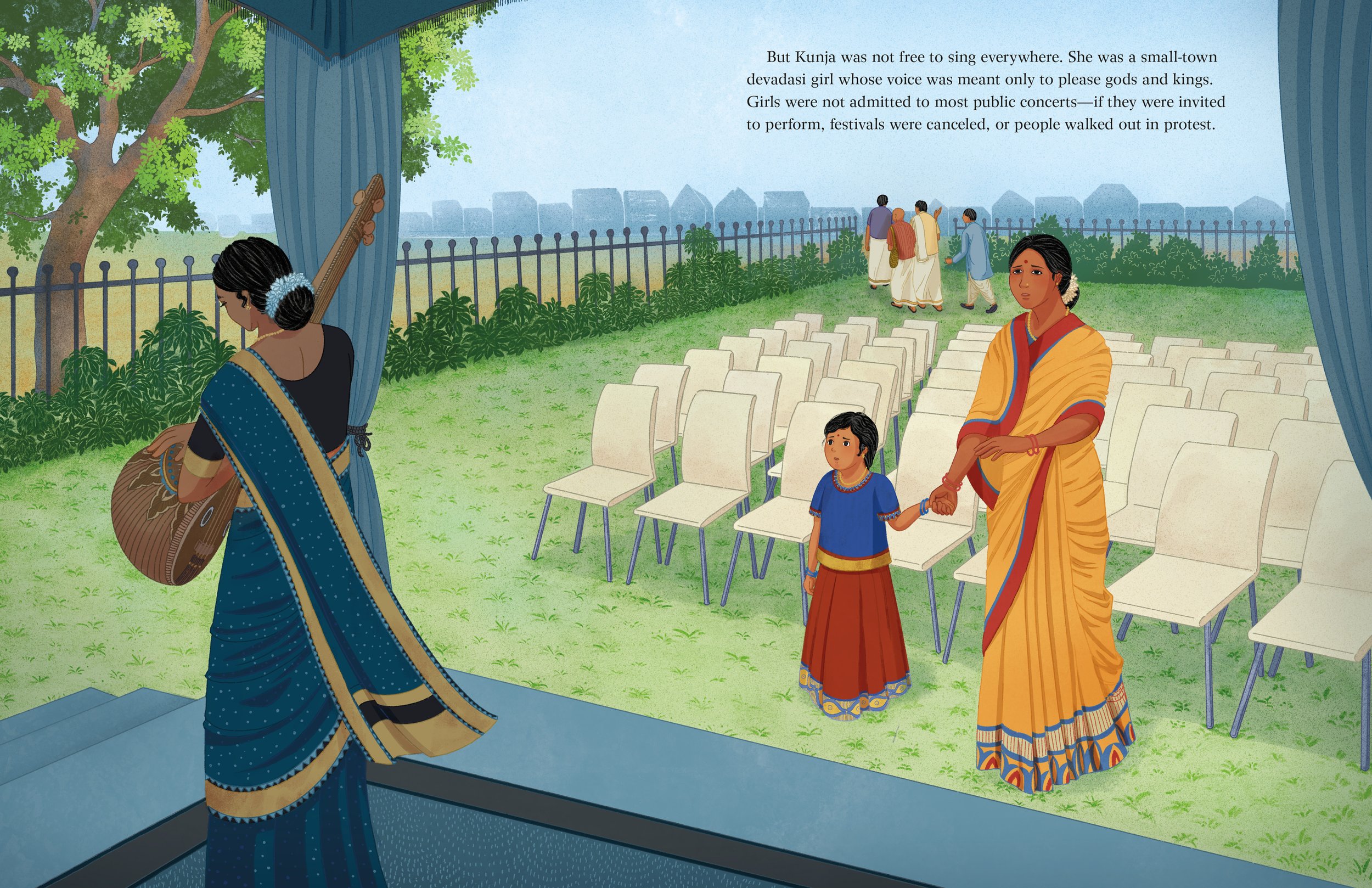Guest post: Suma Subramaniam on She Sang for India
Confession: when I was young, I was a most reluctant student of the great classical tradition of music in South India that is known as Carnatic music. The grownups agreed that I had a nice voice but oh, did I ever lack motivation! I ducked practice. I sulked. I suffered through several years of lessons before finally using upcoming high school exams as the perfect excuse to end the tedium of instruction. I’m sure my music teacher was relieved.
Even so, the voice of M.S. Subbulakshmi made its way into my life on a regular basis, through the radio and through my father’s vast collection of reel-to-reel tapes. By way of habituation, it crept into my auditory memory and has resided there permanently ever since. As I’ve grown older, I’ve come to understand the remarkable story of the woman with that spectacular voice. I’ve long hoped that someone with the right musical and literary inclinations would write a book about her for children. So I’m more than delighted to see Suma Subramaniam’s forthcoming picture book, She Sang for India: How M.S. Subbulakshmi Used Her Voice for Change.
Here’s Suma on how she placed this gentle personality with a towering talent within the pages of her picture book:
When I started writing about M.S. Subbulakshmi, I had it in my head that this wasn’t going to be an arduous task. Her story was all over the internet. It wouldn’t take much effort because she was famous, well-respected, and well-known among people from India and the diaspora.
By the time I finished the draft, I learned how fallible I was. Every book presents its challenges, and this project wasn’t short of that.
As if the subject, M.S. Subbulakshmi wasn’t daunting enough, the project itself turned out to be overwhelming.
When She Sang For India came into being, I quickly realized how much I had to learn about lyrical writing, source notes, the craft of writing picture book biographies, poetry, and backmatter. I learned how the journey of getting this book out in the world required much effort and dedication to the craft, just like M.S. Subbulakshmi’s life.
Little Subbulakshmi lived simply in the early 1900s with no yearning for fancy things or fame. She practiced her craft with consistency. She wasn’t stuck on perfection. She made mistakes. She corrected and improved on them, and she kept singing no matter what obstacle came in her way. In a world dominated by male singers in pre-independent India, Subbulakshmi persisted. The more she sang, the more she learned. She saw long hours of practice as a good thing in her art, although it demanded a lot of patience and courage from her.
I grew up listening to M.S. Subbulakshmi’s voice first thing in the morning every day of my life. For many Indian classical music performers over the years, her story has been nothing short of a superhero’s. Her path was not one that was paved with roses. Subbulakshmi’s music career lasted seven decades. To write about her life in as few words as possible in a 40-page picture book format was challenging.
After having studied over four hundred picture book biographies, I came to an understanding: adaptability and willingness to learn could become my best friends as I tried to tell her fascinating story in a way that children would understand.
Writing her story needed a structure that met the needs of today’s young readers: short, lyrical, poetic nuggets, easy to understand words, and some clear takeaways.
I wrote multiple drafts and had the best beta readers and critique partners in the world who were patient enough to read every single version as I polished the manuscript for several years.
She Sang For India took on a long and emotional journey. It took eight years from idea to publication with a persistent agent, Miranda Paul, and many rejections along the way. Finally, the book received the love of two brilliant editors, Elizabeth Lee and Trisha De Guzman who fell in love with Subbulakshmi’s story and did everything in their capacity to shepherd it to a finished product.
I restarted the revision process. This time, I interviewed Subbulakshmi’s family and with the sound advice of a fantastic editorial team, I rewrote the book with a definite goal in mind. I wanted to show how this small-town girl made a difference in the world by using her voice for social justice. We agreed that everything else would go into the backmatter.
The spreads in the book are divided into roughly three to four sections where Subbulakshmi had the most social impact:
1. What she did in her childhood
2. How she broke societal tradition as a young adult
3. How she contributed toward India’s freedom struggle against the British
4. How she became the first Indian musician to sing for world peace at the United Nations
Although the path to publication was long, devoting my energy and time to this project was joyful. I would not give it up for anything. The entire publishing team at Farrar, Straus & Giroux has been wonderful and forthcoming in this journey. We collaborated on the art every step of the way and went through many revisions andpasses. The illustrator, Shreya Gupta rolled up her sleeves and studied about Subbulakshmi. Her art is absolutely stunning in the pages of the book. Shreya has been an amazing partner in this project. The end result has been rewarding.
These days, when I sit down to write, I keep going back to these two values I learned from M.S. Subbulakshmi that I’d want readers to take away from her story:
• to create a habit of consistent learning and practice in our area of interest
• to have the humility and courage to share our work for the good of the world
Let M.S. Subbulakshmi’s values make us better humans, and may her life be a lesson for all of us.
Thank you, Suma, and congratulations to you and to Shreya on this beautiful book.



